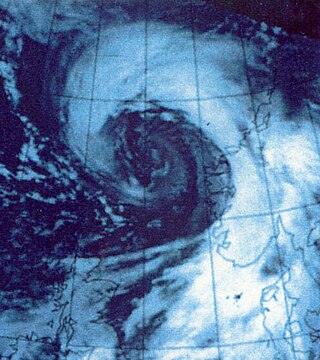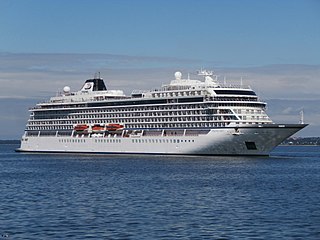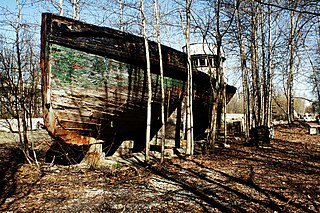
The Kerch Strait is a strait in Eastern Europe. It connects the Black Sea and the Sea of Azov, separating the Kerch Peninsula of Crimea in the west from the Taman Peninsula of Russia's Krasnodar Krai in the east. The strait is 3.1 kilometres (1.9 mi) to 15 kilometres (9.3 mi) wide and up to 18 metres (59 ft) deep. The most important harbor, the Crimean city of Kerch, gives its name to the strait, formerly known as the Cimmerian Bosporus. It has also been called the Straits of Yenikale after the Yeni-Kale fortress in Kerch.

Hurricane Connie was a Category 4 hurricane that contributed to significant flooding across the eastern United States in August 1955, just days before Hurricane Diane affected the same general area. Connie formed on August 3 from a tropical wave in the eastern Atlantic Ocean. It moved quickly west-northwestward, strengthening into a hurricane by August 4. Connie first posed a threat to the Lesser Antilles, ultimately passing about 105 mi (165 km) north of the island group. In the United States Virgin Islands, three people died due to the hurricane, and a few homes were destroyed. The outer rainbands produced hurricane-force wind gusts and intense precipitation, reaching 8.65 in (220 mm) in Puerto Rico. On the island, Connie destroyed 60 homes and caused crop damage. After affecting Puerto Rico, Connie reached maximum sustained winds of 140 mph (220 km/h), and a barometric pressure of 944 mbar (27.9 inHg), as observed by the Hurricane Hunters on August 7. The hurricane later weakened, slowed its forward motion, and turned to the north, striking North Carolina on August 12 as a Category 2 on the Saffir-Simpson scale. Connie was the first of three damaging tropical cyclones in the 1955 hurricane season to hit the state, along with Diane and Ione. The storm progressed inland after moving through the Chesapeake Bay region, and was later absorbed by a cold front over Lake Huron on August 15.

SS Princess Sophia was a steel-built passenger liner in the coastal service fleet of the Canadian Pacific Railway (CPR). Along with SS Princess Adelaide, SS Princess Alice, and SS Princess Mary, Princess Sophia was one of four similar ships built for CPR during 1910-1911.

Norwegian Sky is a Sun-class cruise ship owned and operated by Norwegian Cruise Line. She was originally ordered by Costa Cruises as Costa Olympia from the Bremer Vulkan shipyard in Germany, but she was completed in 1999 by the Lloyd Werft shipyard in Bremerhaven, Germany for the Norwegian Cruise Line under the name Norwegian Sky. Between 2004 and 2008, she sailed as Pride of Aloha for NCL America.

Vágur meaning Bay is a town on the island of Suðuroy, part of the Faroe Islands

Typhoon Ewiniar, known in the Philippines as Typhoon Ester, was the third named storm of the 2006 Pacific typhoon season and one that lasted for twelve days as a tropical cyclone, moving on a generally northward track. During its lifespan, it affected Palau, Yap, eastern China, the Ryūkyū Islands of Japan, South Korea as well as North Korea, briefly threatening to make landfall in North Korea before doing so in South Korea. Ewiniar is responsible for at least 181 deaths. However, an unofficial report stated that up to 10,000 people had been killed by flooding in North Korea, with 4,000 people missing.
Hurricane Nina was the final tropical storm and hurricane of the 1957 Pacific hurricane season and the last storm to form during the active Central Pacific hurricane season this year. This storm was named "Nina" because during this time, hurricanes in this basin were given names from the typhoon naming lists. This storm was the last to form during a series of typhoons to form in the Pacific in November.

Spirit of Vancouver Island is an S-class ferry, part of the BC Ferries fleet. Along with MV Spirit of British Columbia, it is the largest in the BC Ferries fleet. The ship was completed in 1994 and serves the Swartz Bay – Tsawwassen route. In 2018, Spirit of Vancouver Island began a mid-life refit in Poland, where it was converted to a dual-fuel system to allow liquefied natural gas propulsion. The vessel returned to service in 2019.
Wreck Alley is an area a few miles off the coast of Mission Beach, San Diego, California with several ships intentionally sunk as artificial reefs and as Scuba diving attractions for wreck divers.

The New Year's Day Storm, known in Scotland as the 'Hogmanay Hurricane', was an intense European windstorm that affected much of northern Scotland and western Norway on 1 January 1992. DNMI estimated the strongest sustained winds and the strongest gusts to have reached 103 mph and 138 mph, respectively. Unofficial records of gusts in excess of 170 knots (88 m/s) were recorded in Shetland, while Statfjord-B in the North Sea recorded wind gusts in excess of 145 knots (75 m/s). There were very few fatalities, mainly due to the rather low population of the islands, the fact that the islanders are used to powerful winds, and because it struck in the morning on a public holiday when people were indoors. In Norway there was one fatality, in Frei, Møre og Romsdal county. There were also two fatalities on Unst in the Shetland Isles. Despite being referred to by some as a 'Hurricane', the storm was Extratropical in origin and is classified as an Extratropical Cyclone.

The Sea Shepherd Conservation Society engages in various demonstrations, campaigns, and tactical operations at sea and elsewhere, including conventional protests and direct actions to protect marine wildlife. Sea Shepherd operations have included interdiction against commercial fishing, shark poaching and finning, seal hunting and whaling. Many of their activities have been called piracy or terrorism by their targets and by the ICRW. Sea Shepherd says that they have taken more than 4,000 volunteers on operations over a period of 30 years.

Athena is a 7,805 GT factory ship which was built in 1992. In October 2010, she caught fire off the Isles of Scilly. In May 2011 she caught fire while lying at the harbour of Runavík in Skálafjørður, Faroe Islands. It happened at night, and people who lived on the other side of the fjord, where the smoke was headed, were evacuated. Some months later the ship was sold to Smedegaarden in Esbjerg, which took her apart.

Hurricane Celeste of August 1972 was the first known tropical cyclone to strike Johnston Atoll as a hurricane. Forming from a disturbance in the East Pacific on August 6, the storm began a general westward movement it would take throughout most of its life. The storm intensified steadily, becoming a Category 1 hurricane on August 10. It kept steady at this intensity until it reached the Central Pacific. Upon entering the Central Pacific, intensification began anew, and by August 14, the hurricane reached a peak intensity of 130 mph (210 km/h). After maintaining this intensity for twelve hours, the hurricane began to weaken while passing south of Hawaii. The weakening phase was similar to its intensification in that the storm lost intensity slowly. Celeste then made a turn to the northwest and dropped below hurricane intensity on August 21. The storm then entered an area of vertical wind shear, causing it to dissipate soon after.

MV Canadian Miner was a Canadian laker that was part of the fleet of Upper Lakes Shipping from 1994–2011. Initially constructed as Maplecliffe Hall in 1966, the ship was renamed Lemoyne in 1988 before becoming Canadian Miner in 1994. In 2011, the name was shortened to just Miner. In 2011 the vessel was taken out of service and sold for scrapping. While en route to the scrapyard in Turkey, the ship ran aground off Nova Scotia in 2011. The vessel was broken up in 2014 in Nova Scotia.

Typhoon Fitow, known in the Philippines as Typhoon Quedan, was the strongest typhoon to make landfall in Mainland China during October since 1949. The 21st named storm of the 2013 Pacific typhoon season, Fitow developed on September 29 to the east of the Philippines. It initially tracked north-northwestward, gradually intensifying into a tropical storm and later to typhoon status, or with winds of at least 120 km/h (75 mph). Fitow later turned more to the west-northwest due to an intensifying ridge to the east, bringing the typhoon over the Ryukyu Islands with peak winds of 140 km/h (85 mph) on October 5. The next day, the typhoon struck China at Fuding in Fujian province. Fitow quickly weakened over land, dissipating on October 7.

MV Viking Sky is a cruise ship that was launched in 2016 and entered service in 2017. She is operated by Viking Ocean Cruises. On 23 March 2019, she suffered an engine failure off the coast of Norway. A partial evacuation by helicopters took place.

Chacon is a 72 ft (22 m) dry docked wooden vessel and roadside curiosity in Chugiak, Alaska, United States. The former fishing vessel currently serves as a memorial for its most recent owner, Thillman Wallace of Chugiak.

P/F Bakkafrost is a Faroese salmon farming company based in Glyvrar on the island of Eysturoy in the Faroe Islands. Bakkafrost is the largest fish farming company in the Faroe Islands, and is the biggest private employer in the islands. Bakkafrost is the third-largest fish farming company in the world.

Typhoon Emma was a strong typhoon that struck Okinawa during the 1959 Pacific typhoon season. An area of severe weather formed near Kwajalein Atoll on October 30, and the Japan Meteorological Agency (JMA) began tracking it as a tropical depression on November 1. The Joint Typhoon Warning Center followed suit on November 5 after finding a closed circulation, and the depression received the name Emma. The depression strengthened into a tropical storm west of Guam on November 6 and gradually gained strength. Emma became a typhoon on November 11 near Luzon, and it reached its peak sustained winds of 205 km/h; 125 mph (110 kn) later that day. The typhoon turned northeastwards and grazed Okinawa the next day. Emma steadily weakened and became extratropical on November 13, and the JMA ceased tracking the storm on November 15.

















